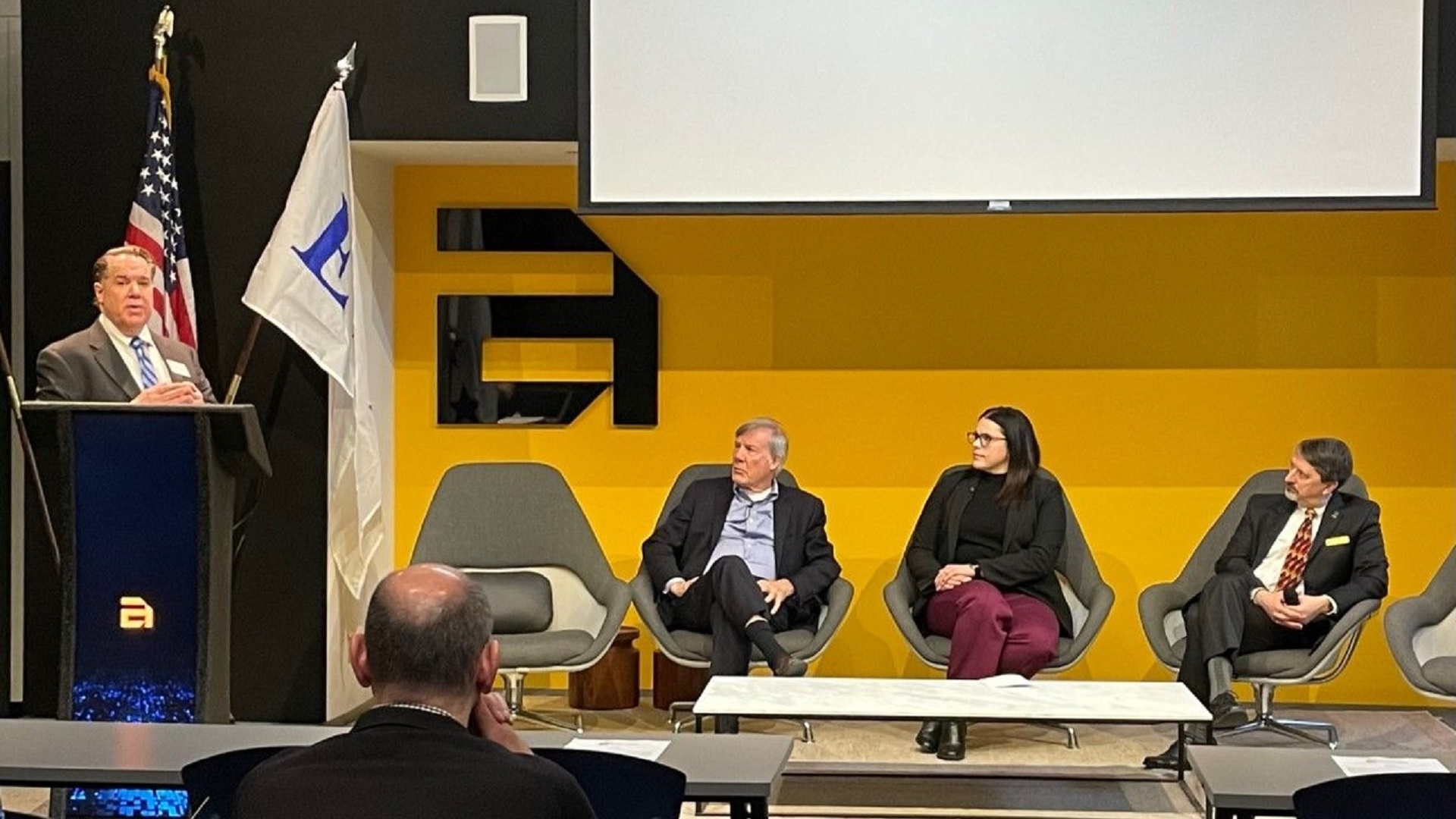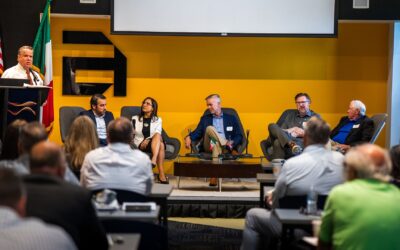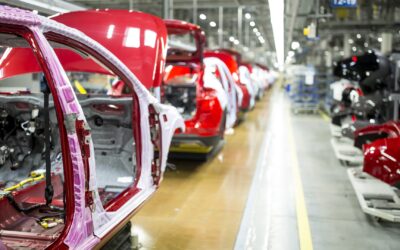After a rocky 2022 defined by inflation, newfound geopolitical tension and labor concerns, Automation Alley hosted the Industry 4.0 Outlook: Advanced Manufacturing in 2023 and Beyond on Jan. 25, informing members on how to navigate the new normal in a post-pandemic and unprecedented time in economic history.
The annual event saw small manufacturers, economists, academics and business experts convene in-person and virtually for a presentation on the 2023 economy, Michigan’s role in Industry 4.0 and a panel discussion Q&A.
For the Global Economic Outlook, Automation Alley welcomed the Managing Director, Head Economist of JP Morgan Chase & Co. James Glassman to present his analysis on the economy looking ahead into 2023. Natalie Chmiko, Senior Vice President of Small Business Solutions at Michigan Economic Development Corporation (MEDC), presented Michigan’s manufacturing outlook.
Here are the key takeaways:
1. Back on Our Feet After Unprecedented Disruption
Glassman opened up his presentation on the global economy with a frank conversation about how there is no established guide on how to fix the economy during this time in our history.
“There is no history book that is relevant to what we’re dealing with,” Glassman said. “When did we ever decide to shut the economy down during a pandemic because our medical system couldn’t handle the burden? When did we ever have the technology to transition quickly from the office to working at home?”
The amount of rapid change brought about by the pandemic to the business and economic community was unprecedented, he added.
According to 2020 data on unemployment from the U.S. Bureau of Labor Statistics, April 2020 saw the national unemployment rate careen up to 14.7%. Most recent Dec. 2022 data shows the rate hovering at 3.5%, the same rate prior to the pandemic in Feb. 2020.
The most significant relief effort signed into law during the crisis was the The Coronavirus Aid, Relief, and Economic Security (CARES) Act, topping the scale at $2.2 trillion in stimulus spending.
“I would give what they did in March 2020 an A+, because if we would’ve dragged our feet economically, it would’ve cost us much more down the road,” Glassman said. “People freaked out over how much money we spent during this crisis, but the truth is if we didn’t it would’ve cost us much more.”
Inflation is the flipside of that coin, he said.
“There is no known moment in our history books where inflation has the same dynamic it has today. This is the problem many of us are having with how leadership in the central banking community is handling this.”
2. Globalization Will Continue
“Some people worry that the pandemic brought about de-globalization, or we are going to get reshoring, but I don’t think so,” Glassman said.
The core labor issues remain, he added.
“The pandemic will accelerate the things we were doing before. When people tell me we need to bring work back to the U.S., where are you going to find the people to staff those jobs? That’s the problem. The incentive to continue on this path will continue.”
According to a study by Deloitte and The Manufacturing Institute, the manufacturing skills gap in the U.S. could result in 2.1 million unfilled jobs by 2030.
“It is the ambitions of undeveloped countries that are driving globalization,” Glassman said. “Most of the world’s living standard is 10 to 20 percent of our level.”
India will be a country to watch in the future of this discussion, Glassman added.
“It has a very young population and is a dynamic place. It is a democracy with a balanced economy.”
3. The Wrong Narrative Between Inflation and Recession
According to Glassman, the problem with inflation and the threat of recession has more to do with supply side issues than a classic demand issue.
“It is all about supply side dislocations caused by the global supply chain debacle and problems caused by the Ukraine War in energy and agriculture,” Glassman said.
“Over the last six months, inflation has come back to two percent. The rate of inflation has slowed down dramatically. What this story tells you is the rate of inflation has gone back to where we were prior to the pandemic. The storm is over.”
Once outliers like used car prices, groceries and rents driving up the Consumer Price Index (CPI) get more under control, these issues will pass fully, he added.
“This just smells like a supply disruption; and if it is, it will pass as quickly as it flared up. We are getting there. As the year goes on, we’ll realize this nightmare is getting behind us and we are back on the path. That’s my story and I’m sticking to it.”
4. Michigan’s Place in The World
Chmiko opened up her presentation with how the State of Michigan is synonymous with manufacturing.
“We are the epicenter of manufacturing in the U.S. We have the legacy, innovation and skill to address challenges and a passion for creating things,” Chmiko said. “Manufacturing is what drives our economy, our prosperity and our livelihoods. Michigan is an example of what manufacturing can be.”
According to Chmiko, Michigan has 14,000 workers employed in industrial machinery manufacturing, making the state a national leader in employment to industries related to Industry 4.0 and automation.
Michigan is also a leader in electrification, Chmiko added.
CNBC recently credited Michigan as one of three states set to dominate electric vehicle manufacturing by 2030. The state is estimated to be able to produce 97 and 136 gigawatt hours’ worth of EV batteries per year by 2030.
“Since 2019, MI has added over 30,000 manufacturing jobs, many of those involving batteries and electric vehicles or other advanced mobility products.”
The reach of the state expands globally as well.
“Last year we elevated Michigan’s role in the global narrative by becoming the World Economic Forum’s US Center for Advanced Manufacturing, which is housed right here at Automation Alley,” Chmiko said.
“These investments have cemented our status as a global epicenter for advanced manufacturing and the digital transformation of Industry 4.0.”
5. New Opportunities for Michigan Manufacturers to Adopt Industry 4.0
To conclude, Chmiko emphasized now is a better time than ever to get involved as a small- and medium-sized manufacturer in Michigan’s Industry 4.0 economy.
“We are providing resources to small manufacturers with education, courses, technology roadshows and technology assessments,” Chmiko said.
“Automation Alley is a key part of this, offering every manufacturer a free essential membership, which gets you a free ticket to Integr8, the largest Industry 4.0 event in the state.”
More than 1,000 technology and manufacturing professionals are expected to convene in Novi, Michigan on May 9, 2023 for Integr8. The day-long conference will include a smart manufacturing exhibition, a keynote presentation, breakout sessions, tech talks, the return of roundtables and a 3D Printing Pitch Competition, hosted by MEDC’s Pure Michigan Business Connect.
Looking forward, Chmiko said all manufacturers should be aware of the MEDC’s Industry 4.0 Technology Implementation Grant, a grant program providing 50% reimbursement for qualifying Industry 4.0 technology costs up to $25,000.
“Within the last seven months since the program launched, we’ve awarded more than $2.5 million to over 110 companies statewide,” Chmiko said.
“These 110 companies anticipate a total of $130 million in increased revenue that will help retain or create over 2,100 jobs.”
Sign up today for a free Essential Membership to Automation Alley to keep your finger on the pulse of digital transformation in Michigan and beyond.
Dennis Burck is Automation Alley's Digital Content Editor, responsible for the organization's content strategy and development. Dennis is a media-savvy professional who builds relationships with Automation Alley members and partners to find and create the best and most relevant content to increase Industry 4.0 awareness and drive traffic to Automation Alley's Industry 4.0 knowledge center.




